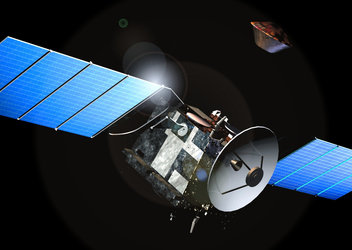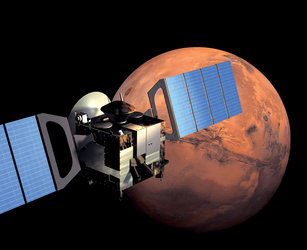Accept all cookies Accept only essential cookies See our Cookie Notice

About ESA
The European Space Agency (ESA) is Europe’s gateway to space. Its mission is to shape the development of Europe’s space capability and ensure that investment in space continues to deliver benefits to the citizens of Europe and the world.
Highlights
ESA - United space in Europe
This is ESA ESA facts Member States & Cooperating States Funding Director General Top management For Member State Delegations European vision European Space Policy ESA & EU Space Councils Responsibility & Sustainability Annual Report Calendar of meetings Corporate newsEstablishments & sites
ESA Headquarters ESA ESTEC ESA ESOC ESA ESRIN ESA EAC ESA ESAC Europe's Spaceport ESA ESEC ESA ECSAT Brussels Office Washington OfficeWorking with ESA
Business with ESA ESA Commercialisation Gateway Law at ESA Careers Cyber resilience at ESA IT at ESA Newsroom Partnerships Merchandising Licence Education Open Space Innovation Platform Integrity and Reporting Administrative Tribunal Health and SafetyMore about ESA
History ESA Historical Archives Exhibitions Publications Art & Culture ESA Merchandise Kids Diversity ESA Brand Centre ESA ChampionsLatest
Space in Member States
Find out more about space activities in our 23 Member States, and understand how ESA works together with their national agencies, institutions and organisations.
Science & Exploration
Exploring our Solar System and unlocking the secrets of the Universe
Go to topicAstronauts
Missions
Juice Euclid Webb Solar Orbiter BepiColombo Gaia ExoMars Cheops Exoplanet missions More missionsActivities
International Space Station Orion service module Gateway Concordia Caves & Pangaea BenefitsLatest
Space Safety
Protecting life and infrastructure on Earth and in orbit
Go to topicAsteroids
Asteroids and Planetary Defence Asteroid danger explained Flyeye telescope: asteroid detection Hera mission: asteroid deflection Near-Earth Object Coordination CentreSpace junk
About space debris Space debris by the numbers Space Environment Report In space refuelling, refurbishing and removingSafety from space
Clean Space ecodesign Zero Debris Technologies Space for Earth Supporting Sustainable DevelopmentLatest
Applications
Using space to benefit citizens and meet future challenges on Earth
Go to topicObserving the Earth
Observing the Earth Future EO Copernicus Meteorology Space for our climate Satellite missionsCommercialisation
ESA Commercialisation Gateway Open Space Innovation Platform Business Incubation ESA Space SolutionsLatest
Enabling & Support
Making space accessible and developing the technologies for the future
Go to topicBuilding missions
Space Engineering and Technology Test centre Laboratories Concurrent Design Facility Preparing for the future Shaping the Future Discovery and Preparation Advanced Concepts TeamSpace transportation
Space Transportation Ariane Vega Space Rider Future space transportation Boost! Europe's Spaceport Launches from Europe's Spaceport from 2012Latest
Mars Express Arrives in Baikonour
Mars Express arrives in Baikonur
In June, the first joint fully European spacecraft is scheduled to take off for Mars.
Just five days prior to reaching Mars, the orbiter will jettison the Beagle 2 lander
The spacecraft container, accompanied by the smaller one for the Beagle 2 lander, arrives at the transport aircraft.
The payload first enters the Payload Preparation Facility clean room, where final assembly is performed along with functional tests.
Mars Express will set off from the Baikonur lanch pad at the beginning of June on a Soyuz-Fregat launcher, arriving at Mars between Christmas 2003 and New Years Eve.
ITW Rudolf Schmidt (German)
ITW Rudolf Schmidt (English)
Mars Express animations
Mars Express loading
Mars Express in the lab
Mars Express loading in Baikonur
Mars Express arrives in Baikonur
A Roll - Script
10 00 40 00
The Red Planet has always fascinated Earthlings. Mars is currently the only planet in the solar system on which there is a possibility of finding life ? past or present. The surface looks hostile, with spectacular mountains and canyons three times as deep and five times as long as the Grand Canyon.
10 00 59 00
In June, the first joint fully European spacecraft is scheduled to take off for Mars. After a six-month interplanetary cruise, ?Mars Express? should arrive at the planet?s doorstep in late 2003. Just five days prior to reaching Mars, the orbiter will jettison the Beagle 2 lander, named after Charles Darwin?s famous ship.
10 01 20 00
The lander will pass through the Martian atmosphere on its way to the surface in around ten minutes. On the landing site it will take measurements of rocks and soil and, like any tourist visiting a new destination, Beagle 2 will take photographs and collect data and then transmit the data back to the orbiter
-
CREDIT
ESA -
LICENCE
ESA Standard Licence
-
Documentary
-
-
-
-
-
-

Artist's impression of Beagle 2 lander

Beagle 2 lander leaving the Mars Express orbiter

Mars Express lift off

The Beagle 2 lander















 Germany
Germany
 Austria
Austria
 Belgium
Belgium
 Denmark
Denmark
 Spain
Spain
 Estonia
Estonia
 Finland
Finland
 France
France
 Greece
Greece
 Hungary
Hungary
 Ireland
Ireland
 Italy
Italy
 Luxembourg
Luxembourg
 Norway
Norway
 The Netherlands
The Netherlands
 Poland
Poland
 Portugal
Portugal
 Czechia
Czechia
 Romania
Romania
 United Kingdom
United Kingdom
 Slovenia
Slovenia
 Sweden
Sweden
 Switzerland
Switzerland


























